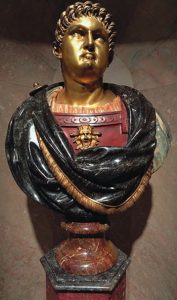The Book of Revelation (7) – Chapters 17:1—19:10
Finally we have arrived at the judgment of the great harlot, the Roman Empire. John is taken in the spirit to the wilderness, from which vantage point he can view the harlot safely, without the risk that he too might be seduced. This is one of John’s most masterful satires. “I saw a woman sitting on a scarlet beast that was full of blasphemous names, and it had seven heads and ten horns. The woman was clothed in purple and scarlet, and adorned with gold and jewels and pearls, holding in her hand a golden cup full of abominations and the impurities of her fornication; and on her forehead was written a name, a mystery: ‘Babylon the great, mother of whores and of earth’s abominations.’ And I saw that the woman was drunk with the blood of the saints and the blood of the witnesses to Jesus.” The beast is Satan, as we remember from chapter 12: “a great red dragon, with seven heads and ten horns.”
John contrasts the woman of chapter 12 with the debauched whore of chapter 17. Both are depicted as mothers, mother of the Messiah on the one hand, mother of whores and of earth’s abominations on the other. Both women are connected to the wilderness, where there is eating and drinking. In chapter 12, after her escape from the dragon, the woman is fed in the wilderness; the whore of chapter 17 consumes the blood of the holy ones in the wilderness. The same Greek participle is used in both chapters to highlight the splendid attire of each woman. In both passages we hear of the “witnesses to Jesus.” These “witnesses” are the “martyrs.” The woman in chapter 17 is an intentionally distorted image of the woman clothed with the sun in chapter 12. The former belongs to Satan’s domain; the latter belongs to God’s heavenly realm.
Craig R. Koester, in Revelation and the End of All Things, has a clever phrase that describes the situation of Christians in John’s churches: “…the message is that Christians may find themselves in difficult straits, like the woman who flees to the wilderness, outside the social mainstream; but if the other option is to cozy up with a debauched prostitute and her pet beast, readers might find that life outside the social mainstream is not so bad.” We remember that the Christians in Sardis and Laodicea are complacent in their wealth, while those in Pergamum and Thyatira seem always ready “to go along to get along” for the sake of social harmony. John hopes that his satire will unmask the powers that seduce his fellow Christians.
John often gives several layers of meaning to his symbols. “The beast that you saw was, and is not, and is about to ascend from the bottomless pit and go to destruction. And the inhabitants of the earth, whose names have not been written in the book of life from the foundation of the world, will be amazed when they see the beast, because it was and is not and is to come.” The beast is a counterfeit of the Lamb who was, is and is to come. Also, “the seven heads are seven mountains on which the woman is seated; also, they are seven kings, of whom five have fallen, one is living, and the other has not yet come; and when he comes, he must remain only a little while. As for the beast that was and is not, it is an eighth but it belongs to the seven, and it goes to destruction.” The first part is obvious – Rome is situated on seven hills. Many have tried to puzzle through the riddle of the kings, with results that satisfy to one degree or another, but not completely. John’s audience didn’t need a riddle to figure out who the Roman emperor was – they already knew! Somehow, the riddle relates to the emperor Nero, the first to persecute Christians. Perhaps it is best to remember that “seven” is a number symbolizing completeness. John may be saying, “Whether it’s Domitian or any other emperor, it’s Nero all over again.”
The ten horns on the beast are kings that serve the beast but will be destroyed by the Lamb. But first, “…the ten horns that you saw, they and the beast will hate the whore; they will make her desolate and naked; they will devour her flesh and burn her up with fire.” John has a whole stock of images from the Old Testament prophets to describe Israel herself as a whore, who embraces pagan gods (Hosea 2:5; Jeremiah 2:20; Ezekiel 16:36, etc). Now some members of the Church are also prostituting themselves to Roman imperial ways, including emperor worship. Perhaps in the description of the destruction of the harlot John has in mind the poetic passage in Jeremiah 4:30: “And you, O desolate one,/ what do you mean that you dress in crimson,/ that you deck yourself with ornaments of gold,/ that you enlarge your eyes with paint?/ In vain you beautify yourself./ Your lovers despise you; they seek your life.” The beast and its allies start by waging war against the Lamb, but end up destroying the harlot.
Chapter 18 describes Babylon/Rome’s funeral. The mourners are all who have profited from complying with pagan Roman ways – conquered kings, merchants, etc. John has these mourners describe the fall of the great city in the manner of a Greek chorus. Rome is judged for idolatry and the violence of conquests that made her dominant in the Mediterranean. The cargoes of the merchants include necessary items but also many lavish luxuries (available only to the rich). John indicts the Roman use of slavery; the list of the merchants’ cargoes concludes with “slaves – and human lives.” Babylon/Rome’s brutality is responsible for “the blood of the prophets and of saints, and of all who have been slaughtered on earth.”
Handel based the “Hallelujah chorus” on chapter 19 of Revelation. In contrast to those who mourn on earth, heaven breaks out in joyful praise of God, celebrating the fall of the great whore. In contrast, the people of God are the bride of the Lamb.
Next month: Revelation 19:11--22:5, seven pictures of the End.


 Entries(RSS)
Entries(RSS)